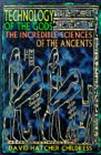David Hatcher Childress, known as the real-life Indiana Jones to the many fans of his books, is a captivating speaker and the author or coauthor of over 15 books. He has traveled the world several times over, seeking adventure and the answers to the mysteries of mankind¹s past. We welcome David as the March 2009 Author of the Month.
All of David Childress Hatcher’s books are available through the publishing company he and his wife own and operate. www.adventuresunlimitedpress.com and through the Amazon links provided.
The Strange World of the Olmecs
The oldest and probably greatest mystery of early Mexico and North America in general, is the problem of the Olmecs. Olmecs are now often referred to as Proto-Mayans by academic archeologists, or Olmans, meaning inhabitants of Olman, the “Olmec Land” as it is now being called. When one looks at the enigmatic cave drawings, the gigantic, perfectly carved heads, the trademark “frown,” and the violent, militaristic look of the Olmecs, an emphatic question leaps to the forebrain: “Who are these weirdos?”
What is fascinating about this enigmatic civilization to us modern viewers is how they represented themselves. In addition to these showing Negroid features, many artifacts depict individuals who have Oriental or European features. It is therefore very interesting to pay close attention to how the figures are presented-how they dressed; the head gear they wore; the shape of their eyes, nose, ears and mouths; the way they held their hands; and the expressions on their faces. It is all wonderful art at its finest. The expressions and symbolism in the objects they hold or are associated with seem to indicate a high level of sophistication and a shared iconography-What does it all mean? Who are these people? Were they isolated villagers or strangers from a faraway land?
Until the 1930s it was largely held that the oldest civilization in the Americas was that of the Maya. The great quantity of Mayan monuments, steles, pottery, statues and other artifacts discovered throughout the Yucatan, Guatemala and the Gulf Coast of Mexico had convinced archeologists that the Maya were the mother civilization of Central America.
But some “Mayan artifacts” were different from the main bulk of the artifacts in subtle ways. One difference was that some carvings of large heads had faces with more African-looking features than many of the other Mayan works. Mayan paintings and sculpture can be quite varied but the African-looking features seemed distinctly un-Mayan. These African-looking heads often had a curious frown and often wore masks or appeared to be a half-jaguar-half-man beast. This recurring motif did not fit in with other Mayan finds.

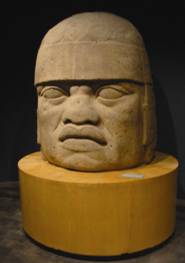
Colossal sculpted heads of the mysterious Olmec people of Central America
In 1929, Marshall H. Saville, the Director of the Museum of the American Indian in New York, classified these works as being from an entirely new culture not of Mayan heritage. Somewhat inappropriately, he called this culture Olmec (a name first assigned to it in 1927), which means “rubber people” in Nahuatl, the language of the Mexica (“Aztec”) people. Most of the early anomalous artifacts were found in the Tabasco and Veracruz regions of southern Mexico, a swampy region exploited for natural gas, but in ancient times a source point for rubber.
Indeed, the Olmecs are now credited with creating the ball game that played such a significant role in all Mesoamerican civilizations, and the rubber balls that were used in the game. This game may be even older than the Olmecs, in fact. Ball courts and the Olmec-Mayan ball game were popular even as far north as Arizona and Utah and as far south as Costa Rica and Panama.
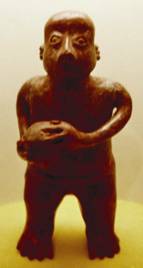
Olmec ball carrying figure
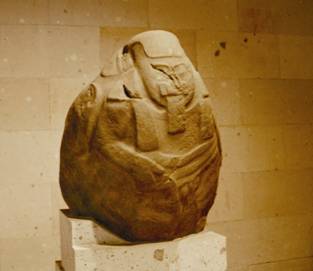
Olmec sculpture of a bearded figure
The Olmecs had been discovered. However, this discovery created more questions than there were answers. The discovery of the Olmecs seemed to cast into doubt many of the old assumptions concerning the prehistory of the Americas. Suddenly, here was a diverse-looking people who built monumental sculptures with amazing skill, were the actual “inventors” of the number and writing system used by the Maya, the ball game with its rubber balls and even knew about the wheel (as evidenced by their wheeled toys).
The greater enigma was upon the archeologists-who were the Olmecs?
It is not known what name the ancient Olmec used for themselves; some later Mesoamerican accounts seem to refer to the ancient Olmec as “Tamoanchan.” The classic period for the Olmecs is generally considered to be from 1200 BC ending around 400 BC. Early, formative Olmec artifacts are said to go back to 1500 BC, and probably earlier.
No one knows where the Olmecs came from, but the two predominant theories are:
- They were Native Americans, derived from the same Siberian stock as most other Native Americans, and just happened to accentuate the Negroid genetic material that was latent in their genes.
- They were outsiders who immigrated to the Olman area via boat, most likely as sailors or passengers on transoceanic voyages that went on for probably hundreds of years.
At the center of the debate about the origin of the Olmecs is the classic struggle between isolationists (who think that ancient man was incapable of transoceanic voyages, and therefore, nearly every ancient culture developed on its own) and diffusionists (who think that ancient man could span the oceans, which explains similarities in widely disparate cultures). There are a few proponents of diffusionism at the traditional academic level. Ivan Van Sertima of Rutgers University in New Jersey actively promotes the diffusionist theory that ancient man crossed both the Atlantic and the Pacific in prolonged transoceanic contact. His books, African Presence in Early America and African Presence in Early Asia, are filled with articles and photos that show without a doubt that Negroes have lived, literally, all over the world, including the ancient Americas. While Van Sertima does not bring in such unorthodox theories as Atlantis or a lost continent in the Pacific, he is clearly of the belief that Negroes in ancient times developed many advanced civilizations and lived all over the globe.
Unfortunately, most of the writers in the academic field prefer to champion the isolationist theories to the virtual exclusion of the diffusionist.
In the recent scholarly book by Richard A. Diehl, The Olmecs: America’s First Civilization, Diehl has only one paragraph on the subject, saying:
The origins of Olmec culture have intrigued scholars and lay people alike since Tres Zapotes Colossal Head I, a gigantic stone human head with vaguely Negroid features, was discovered in Veracruz 140 years ago. Since that time, Olmec culture and art have been attributed to seafaring Africans, Egyptians, Nubians, Phoenicians, Atlanteans, Japanese, Chinese, and other ancient wanderers. As often happens, the truth is infinitely more logical, if less romantic: the Olmecs were Native Americans who created a unique culture in southeastern Mexico’s Isthmus of Tehuantepec. Archeologists now trace Olmec origins back to pre-Olmec cultures in the region and there is no credible evidence for major intrusions from the outside. Furthermore, not a single bona fide artifact of Old World origin has ever appeared in an Olmec archaeological site, or for that matter anywhere else in Mesoamerica.
With this paragraph Diehl summarily dismisses all theories and evidence of transoceanic contact. We don’t really know what a bona fide artifact would be, since Old World and New World articles were often identical, as we shall see. Also, we are given no further information on the pre-Olmec cultures that the Olmecs are presumably derived from.

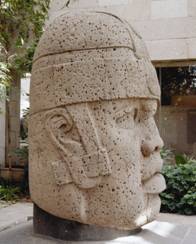
The author with colossal carved and sculpted heads of the Olmec culture
But for the Olmecs to actually be Africans-not just look like them-they would almost certainly have come to the Isthmus of Tehuantepec via ship. But since such voyages are dismissed immediately and there will be no further discussion of it, the Olmecs simply have to be local boys who have always pretty much been there. At some time in remote prehistory, their early genetic group walked into this Olmec heartland area.
According to Diehl, the Olmecs would have been an isolated group within their region as well, with little contact with other tribes in the Isthmus of Tehuantepec. Says Diehl:
We do not know what these people called themselves, or if they even had a term that encompassed all the inhabitants of Olman. There is no evidence that they formed a single unified ethnic group, and almost certainly no Olmec considered people living more than a few hours’ walk away as members of his or her own group. Nevertheless, the numerous independent local cultures were so similar to one another that modern scientists consider them a single generic culture.
The Olmecs are said to have occupied “The Land of Olman.” This was a designation that the Aztecs used to describe the jungle areas of the nearby coast. The traditional definition of the Olmecs is that they were an ancient Pre-Columbian people living in the tropical lowlands of south-central Mexico, roughly in what are the modern-day states of Veracruz and Tabasco on the Isthmus of Tehuantepec. Their immediate cultural influence went much further though, as their artwork has been found as far away as El Salvador and Costa Rica.
The heartland of the Olmecs is also the narrowest land area in Mexico, an area extremely important if an ocean-to-ocean trade route were to be established. This narrow area of southern Mexico is known as the Isthmus of Tehuantepec and it represents the shortest distance between the Gulf of Mexico and the Pacific Ocean.
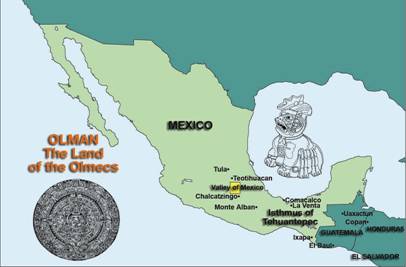
The Olmecs are also known to have occupied, or at least influenced, large areas of lower Central America, from Guatemala and El Salvador to Nicaragua, Costa Rica and probably beyond. One of the most famous statues in the Nacional Museum in San Jose, Costa Rica is an Olmec hunchback figure with an elongated cranium and oriental-type Olmec eyes. Costa Rica is also the site of the enigmatic, perfectly formed granite balls that defy explanation. Were they made by the Olmecs in a similar manner as the colossal heads?
Given that sites like Tonalá and Izapa were early Olmec sites that were later occupied by the Maya, other sites such as Monte Alban further north towards the Valley of Mexico can be assumed to have been first inhabited by the Olmec and then by later cultures.
Once the Olmecs had been established as the oldest culture in Mesoamerica in the 1940s, by default they became the founders of many of the ancient cities. Essentially, if it could be proven that Olmec iconography was being used at an archeological site, then it must have been the Olmecs who founded that city, since the Olmecs are the oldest culture. While there may well have been earlier cultures than the Olmecs in Mesoamerica, none have been specifically identified by archeologists (at least that I am aware of).
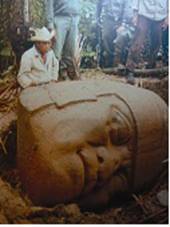
Villahermosa excavation site
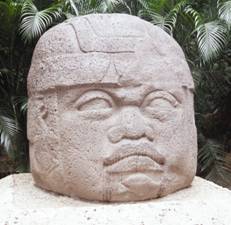
Olmec head on display
Since the oldest Maya sites such as Uaxactun in the Peten jungles north of Tikal are thought to have been first built by the Olmecs, it is possible that other older Mayan sites were also founded by the Olmecs. This list of Mayan sites founded by the Olmecs could include Copan, El Mirador, Piedras Negras and many others.
The more we find out about the Olmecs, the deeper the mystery surrounding them becomes. We find that the Olmecs seem to include nearly every racial type in the world. How is this possible? The Olmecs are credited with everything from inventing the wheel, the ballgame and hieroglyphic writing, and it is now known they controlled most of southern Mexico from shore to shore. From a diffusionist point of view, the Land of Olman may well have been the “center of the world” as the Ithmus of Tehuantepec would indeed have been the center of the world if there was a strong transoceanic trade across both the Atlantic and Pacific Oceans. If such a trade and movement of ships had existed, the Olmecs may well have been a cosmopolitical center where worldwide cultures intermingled.
Born in France in 1957 and raised in the mountains of Colorado and Montana, David¹s curiosity about the world was piqued at a young age. He attended the University of Montana where his studies in oriental culture and philosophy led him to a job teaching English in Taiwan. In 1976, David left the United States on what would become a six-year research and adventure odyssey. During this time, he studied first-hand the ancient civilizations of Africa, the Middle East and China, sometimes journeying into dangerous territory along the way (like Uganda during the overthrow of Idi Amin).
By 1984, Childress had written two books about his journeys, Lost Cities of Africa and Arabia and Lost Cities of China, Central Asia and India. Further expeditions to South America in the 1980s resulted in Lost Cities and Ancient Mysteries of South America, which became a top-ten seller in Brazil. Childress has continued his global research and has rounded out his series with Lost Cities of Ancient Lemuria & the Pacific; Lost Cities of North and Central America; Lost Cities of Atlantis, Ancient Europe & the Mediterranean; Ancient Tonga & the Lost City of Mu¹a and Ancient Micronesia & the Lost City of Nan Madol. His style is an entertaining blend of personal experience and well-researched fact, and these books present fascinating information on the advanced technology and anomalous architecture of our predecessors around the globe.
David has a wide scope of interests, and is a recognized expert not only on ancient civilizations and technology, but also on free energy, anti-gravity and UFOs. His books on these subjects include: The Anti-Gravity Handbook; Anti-Gravity & the World Grid; Anti-Gravity and the Unified Field; Extraterrestrial Archeology; Vimana Aircraft of Ancient India & Atlantis; The Free-Energy Device Handbook and Man-Made UFOs 1944-1994. His latest efforts are A Hitchhiker¹s Guide to Armageddon and Atlantis and the Power System of the Gods.
After more than 20 years of investigating these arcane subjects, David finds his unique views and ideas gaining popularity. He has appeared on Fox-TV¹s Sightings & Encounters, two NBC-TV specials, The Conspiracy Zone, and segments for the Discovery Channel, A&E, and the History Channel. He is also a frequent guest on nationally syndicated radio shows. He continues to explore, write and excite people about discovery through his magazine, World Explorer, and his publishing company, Adventures Unlimited Press.





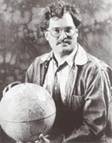


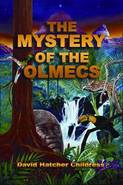

![The Tesla Papers: Nikola Tesla on Free Energy & Wireless Transmission of Power [ILLUSTRATED] (Paperback)](/wp-content/uploads/2014/12/ChildressD1-image013.jpg)

